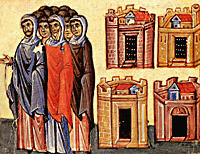General introduction
 he society of the Late Byzantine period is inextricably linked to the political and economic situation of the state. Both the internal structure and
he society of the Late Byzantine period is inextricably linked to the political and economic situation of the state. Both the internal structure and
 demographic evolution as well as the everyday life unmistakably delineate a period of decline. demographic evolution as well as the everyday life unmistakably delineate a period of decline.
An important characteristic of the time was the increase in the power of the aristocracy in every area of life, a fact that engendered intense social conflict between the classes. At the top of the social ladder were the aristocrats, who were often high-ranking members of the military and ecclesiastical establishment. The largest and most productive part of the population consisted of paroikoi and landless or indigent workers. Soldiers, and the class of merchants and manufacturers must be mentioned as separate social groups.
As far as everyday life is concerned, the development of the city was determined by the importance of its economic, administrative or military role. In the rural areas, the village and the family, during this period also, remained the basic forms of social organisation.
The increasing drop in the standards of living, the
decrease in the numbers of the population as well as its intense mobility,
constitute important demographic signs heralding the imminent fall of the
Byzantine Empire.
|